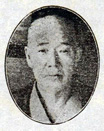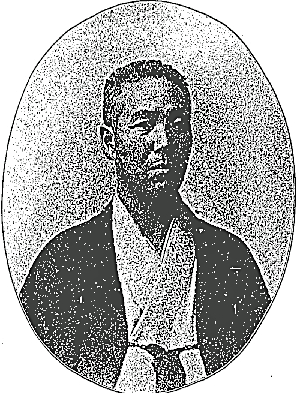OGATA GEKKO
(September 10, 1859 - October 1, 1920)
Ogata Gekko’s life story is as compelling as his art. He was born Nakagami Masanosuke, also known as Tanaka or Tai Masanosuke, in Saemon-cho in the Kobayashi district of Edo (modern day Tokyo), and lived most of his life in the Kobayashi district in Oke-cho. His father Nakagami Seijiro was a rich tradesman who, along with Gekko's grandfather Nakagami Chobei, ran a temporary employment agency for sovereigns, the rich nobility and rich merchants. This business had been in the family for several generations, and they were also licensed to dispose of Edo's garbage.
Gekko was orphaned at the age of 16 when his father died and his family lost their businesses and had to open a lantern shop. The teenage Gekko survived by designing rickshaws and selling his drawings. His rickshaws were shown at the Interior Exhibition of Industrial Design as examples of fine contemporary craftsmanship. It didn't take long for his exceptional artistic talent to be recognized.
After this and after producing an immense number of paintings and sketches, he was recognized by such important figures as the artist Kawanabe Kyosai (often credited for 'discovering' Gekko) and the famous Ogata family, direct descendants of one of Japan's most celebrated artists, Ogata Korin (who was himself older brother to the legendary artist, Ogata Kenzan). Ogata Koya adopted him and the young artist appended their family name to the name he gave himself, Gekko, which means 'Moonlight'. In 1885, his art career took a big leap forward and lifelong friendships were begun when he exhibited a painting in the 1st exhibition of the Japanese art association Kanga Kai, founded by the influential art scholars, Ernest F. Fenollosa and Okakura Tenshin (aka Okakura Kakuzo), who would become regular visitors to Gekko's home. (Gekko was said to have been a gregarious host who enjoyed taking guests into his garden.)
Though Gekko would later become a founding member and developer of several important art institutions, including Nihon Bijutsu Kyôkaï, Nihon Seinen Kaïga Kyôkaï (the Japan Youth Painting Association), the Academy of Japanese Art, the Bunten (the Ministry of Education's annual juried exhibition), and an actively participating member of the Nihon Bijitsuin and the Meiji Fine Art Association, he never attended art school himself, nor did he undergo the traditional apprenticeship in a print maker’s studio. In a society that discouraged self-promotion, Gekko began his art career by preparing flyers and taking them around to various publishers and places to sell his services as an illustrator for magazines and newspapers and a designer of lacquerware and pottery.
He not only broke societal rules, he broke all the rules of print making and created a style so unique and inimitable, wood block carvers and printers today wonder at the challenges he created for their professions. Carvers and printers required clear lines and separated colors from the print designers. Gekko defied these requirements and did not make their jobs easy. Because he began his career as a painter and illustrator, and was a self-taught artist unburdened with the rules of print making, many of his prints achieved a painterly look that was thought impossible for prints, much akin to a Turner watercolor. They have the illusion of brushstrokes, the colors blend into each other and are awash, and the perspectives are unique to Gekko. Like Turner, he created his art in situ (on site) and thoroughly researched his subjects. This singular style of his is well realized in his series of triptychs, Bijin Meisho Awase (Beautiful Women in Famous Places), and reached its highest expression later in his career with his series, 100 Views of Mount Fuji, and in many of the shishikiban (square format) prints that were also from the later part of his career. He continued defying convention and taking risks late in his career, exhibiting in juried exhibitions at an age when no other established artist would dare take the risk of competing against younger artists for prizes. His art continually evolved throughout his career.
Gekko chose a great variety of subjects for his prints, from everyday life in the streets and homes of Japan and serene nature prints with their highly detailed bird plumage, to the violence of war in prints that he designed. While other print artists turned out workmanlike war prints, Gekko created artistic prints that conveyed the horror and emotions of war.
Although his techniques were thoroughly modern, Gekko considered himself to be firmly rooted in the ukiyo-e tradition. In fact, one of his first series of prints was titled Ukiyo Junikagetsu, 12 Months of Ukiyo. Also in the ukiyo-e tradition, he made a Tale of Genji series and a 47 Ronin series of prints.
Though he had no teacher himself, he had some outstanding pupils during a 30 year teaching career, including Yamamura Toyonari (Koka), his son Ogata Getsuzan, Kanamori Nanko, and Tsukioka Kôgyo ( 1869-1927 ), whose mother had married the Meiji Period’s other great artist, Tsukioka Yoshitoshi.
Yoshitoshi has enjoyed more fame than Gekko, and his artwork commands far higher prices than Gekko’s, despite Gekko being arguably the better and more important artist, and despite him being the first Japanese artist in any medium to receive official and widespread international critical acclaim, in the form of prizes at international competitions in Chicago (1893 Columbus Exhibition for his painting A Festival of Sanno at Yedo), Paris (the 1900 Paris Exposition), the 1904 World Fair in St. Louis, and and London (the 1910 Japan-British Exhibition). He also won numerous prizes at prestigious Japanese national competitions such as, to name just a few, the 1893 2nd Annual and 1894 3rd Annual Art Kyoshin Kai (1st and 3rd place medals, respectively for his paintings Chigo Yugizu and Kibeki zu), and the 1896 1st Annual and 1897 2nd Annual Japanese Art Association Competitive Exhibitions (1st and 3rd place medals, respectively for his paintings Hichi Yume and Yoshi-iye). In 1898 Emperor Meiji purchased his painting Soga Yato. Furthermore, Gekko had the good taste and higher artistic sense to mostly avoid many of the gaudy trends that were exploited by other, more popular print artists of the Meiji Period, such as the heavy use of bright red and purple dyes.
An analogy can be legitimately drawn between the careers of Gekko and Yoshitoshi and those of legendary vocal artists, Ella Fitzgerald and Billie Holiday. Both Gekko and Ella Fitzgerald were orphaned at young ages, and picked themselves up by the bootstraps and made illustrious careers for themselves. Both Yoshitoshi and Billie Holiday suffered from acute mental illness and died prematurely. Society admires and is inspired by the rags-to-riches stories of artists like Gekko and Ella, but they are absolutely captivated by the dramatic stories of artists who are unable to overcome their demons and who meet tragic endings, like Yoshitoshi and Billie. Their enthrallment with these stories results in many more books, articles, documentaries, plays, and films being produced about such artists than we see for artists who have longer and more fruitful careers. The public then has more familiarity with the tragic artist and their work than they do with the work of superior artists like Ella and Gekko.
Gekko's status is changing though, due to two important events. Most importantly, the passing of the great ukiyo-e collector and arbiter of taste, Robert O. Muller, and the bequeathing and dissemination of his collection revealed him to have been a great admirer and collector of not only Gekko's prints, but also his paintings. This created a wave of curiosity regarding Gekko, and a re-assessment of his place among Japanese painters and print artists. Secondly, the creation of the first Ogata Gekko website (ogatagekko.com) devoted entirely to educating the public about Gekko did much to give this incomparable and innovative artist his rightful place in the pantheon of Japanese artists, and validation to those who have always felt that Ogata Gekko is one of Japan's greatest artists.

